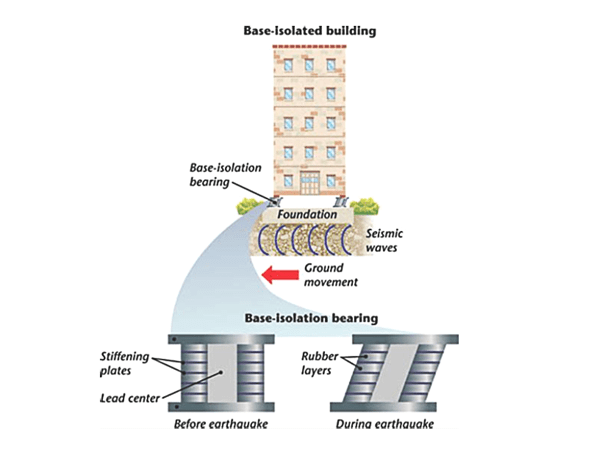
Lead rubber bearing, short for LRB, is a kind of seismic isolation bearing that adds one or more lead cores inside a common natural rubber bearing and absorbs seismic energy by relying on the plastic deformation of lead cores.
LRB has a large vertical stiffness that allows it to support buildings stably; besides, it has a small horizontal stiffness that achieves the displacement of the bearing and offers a horizontal restoring force via the shear deformation of laminated rubber.
It can be used in the seismic isolation systems alone and adjust damping by regulating the diameter or number of lead cores to offer great design flexibility.
As an effective seismic isolation device, LRB is widely used in residential buildings, office buildings, teaching buildings, hospitals, town halls, museums, factories, etc.
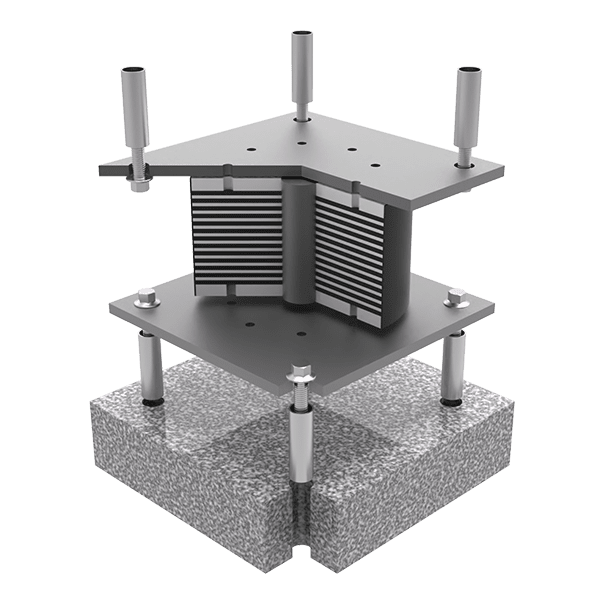
Install a lead rubber bearing at the bottom or in the middle of the building to form a seismic layer and separate the upper structure from the lower foundation. When the earthquake occurs, the vibration energy of the lower foundation will be transferred to the lead rubber bearing first. When the LRB displaces horizontally, metal lead cores inside can not only provide a lateral resistance but also dispatch seismic energy through its deformation when large deformation occurs. In this way, the transmission of seismic energy to the superstructure can be effectively avoided or reduced, thereby ensuring the safety of the superstructure and personnel & devices inside and the normal operation of indoor equipment.


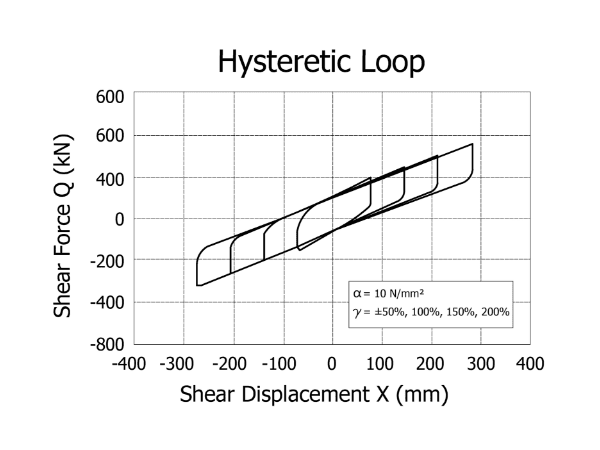
The shear displacement hysteresis curve of the LRB reflects the deformation characteristics and energy consumption of the LRB in the process of repeated stress. The curve shape is full, indicating that the LRB has great plastic deformation capacity, good seismic isolation performance, excellent energy dissipation capacity, and amazing good stability.
Lead rubber bearings are divided into round and rectangular lead rubber bearings by shape.
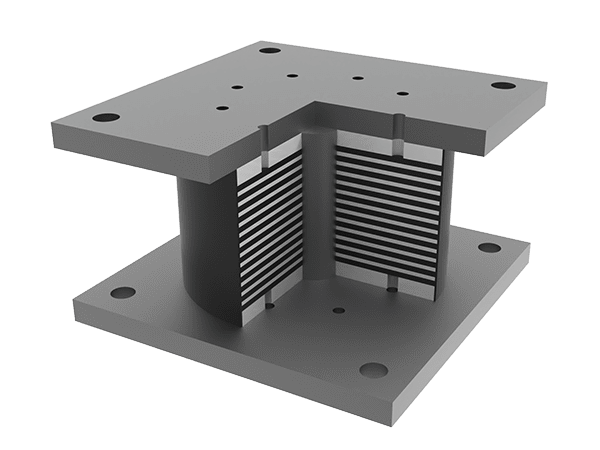
Round lead rubber bearing
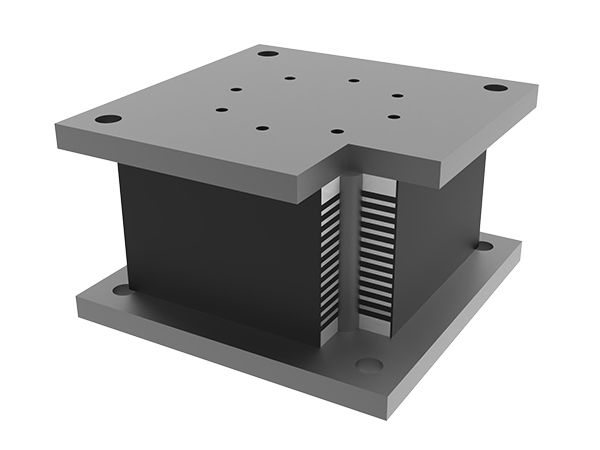
Rectangular lead rubber bearing
Lead rubber bearing consists of a top and a bottom connecting steel plates, one or more lead cores, internal natural rubber layers, internal steel plates, a rubber cover and a top and a bottom sealing plates.
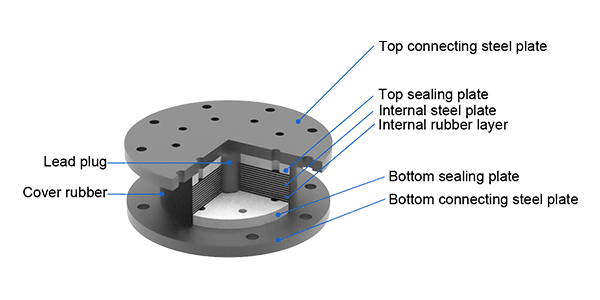
Round lead rubber bearing structure
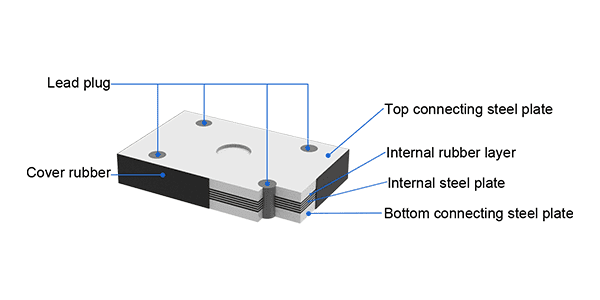
Rectangular lead rubber bearing structure
| Item | LRB (G4) | LRB (G4) | LRB (G4) | LRB (G4) | LRB (G4) | LRB (G4) | LRB (G4) | LRB (G4) | LRB (G4) | |||
|---|---|---|---|---|---|---|---|---|---|---|---|---|
| 600-100 | 650-130 | 700-140 | 750-160 | 800-170 | 900-180 | 1000-200 | 1100-220 | 1200-240 | ||||
| Material property | Shear modulus (N/mm2) | 0.39 | ||||||||||
| Shape, dimension and dimensional accuracy of all parts | Rubber diameter (mm) | 600 | 650 | 700 | 750 | 800 | 900 | 1000 | 1100 | 1200 | ||
| Lead core diameter (mm) | 100 | 130 | 140 | 160 | 170 | 180 | 200 | 220 | 240 | |||
| Total rubber thickness (mm) | 200 | 201.6 | 198 | 201.6 | 200 | 197.2 | 203 | 203 | 203 | |||
| 1st shape factor | 37.5 | 38.7 | 38.9 | 39.1 | 40 | 38.8 | 35.7 | 39.3 | 42.9 | |||
| 2nd shape factor | 3.0 | 3.2 | 3.5 | 3.7 | 4.0 | 4.6 | 4.9 | 5.4 | 5.9 | |||
| Connecting plate diameter (mm) | 1000 | 1050 | 1100 | 1150 | 1200 | 1300 | 1400 | 1500 | 1500 | |||
| Connecting plate thickness (mm) | 27 | 27 | 31 | 31 | 36 | 36 | 41 | 41 | 50 | |||
| Overall height (mm) | 419.9 | 415.3 | 411.7 | 437.5 | 453.7 | 425.1 | 419.4 | 419.4 | 523.4 | |||
| Vertical property | Vertical stiffness | Kv | (103 kN/m) | 1766 | 2102 | 2491 | 2817 | 3284 | 4128 | 4660 | 6042 | 7605 |
| Datum level pressure (N/mm2) | 6 | 6 | 8 | 8 | 10 | 12 | 15 | 15 | 15 | |||
| Horizontal property | Initial stiffness K1 | Ku | (103 kN/m) | 7.21 | 8.44 | 9.97 | 11.27 | 12.92 | 16.54 | 19.84 | 24,.1 | 28.57 |
| Secondary stiffness K2 | Kd | (103 kN/m) | 0.554 | 0.649 | 0.767 | 0.867 | 0.994 | 1.273 | 1.526 | 1.847 | 2.198 | |
| Equivalent stiffness | Keq | (103 kN/m) | 0.87 | 1.17 | 1.39 | 1.66 | 1.90 | 2.30 | 2.76 | 3.34 | 3.97 | |
| Designed nominal horizontal displacement (%) | 100 | |||||||||||
| Notes: Other specifications are available upon request. |
||||||||||||
| Item | LRB (G6) | LRB (G6) | LRB (G6) | LRB (G6) | LRB (G6) | LRB (G6) | LRB (G6) | LRB (G6) | LRB (G6) | |||
|---|---|---|---|---|---|---|---|---|---|---|---|---|
| 600-100 | 650-130 | 700-140 | 750-160 | 800-170 | 900-180 | 1000-200 | 1100-220 | 1200-240 | ||||
| Material property | Shear modulus (N/mm2) | 0.55 | ||||||||||
| Shape, dimension and dimensional accuracy of all parts | Rubber diameter (mm) | 600 | 650 | 700 | 750 | 800 | 900 | 1000 | 1100 | 1200 | ||
| Lead core diameter (mm) | 100 | 130 | 140 | 160 | 170 | 180 | 200 | 220 | 240 | |||
| Total rubber thickness (mm) | 200 | 201.6 | 198 | 201.6 | 200 | 197.2 | 203 | 203 | 203 | |||
| 1st shape factor | 37.5 | 38.7 | 38.9 | 39.1 | 40 | 38.8 | 35.7 | 39.3 | 42.9 | |||
| 2nd shape factor | 3.0 | 3.2 | 3.5 | 3.7 | 4 | 4.6 | 4.9 | 5.4 | 5.9 | |||
| Connecting plate diameter (mm) | 1000 | 1050 | 1100 | 1150 | 1200 | 1300 | 1400 | 1500 | 1500 | |||
| Connecting plate thickness (mm) | 27 | 27 | 31 | 31 | 36 | 36 | 41 | 41 | 50 | |||
| Overall height (mm) | 419.9 | 415.3 | 411.7 | 437.5 | 453.7 | 425.1 | 419.4 | 419.4 | 523.4 | |||
| Vertical property | Vertical stiffness | Kv | (103 kN/m) | 2259 | 2648 | 3077 | 3472 | 3940 | 5029 | 5994 | 7252 | 8631 |
| Datum level pressure (N/mm2) | 6 | 6 | 8 | 8 | 10 | 12 | 15 | 15 | 15 | |||
| Horizontal property | Initial stiffness K1 | Ku | (103 kN/m) | 9.83 | 11.30 | 13.34 | 14.96 | 17.16 | 22.14 | 26.56 | 32.13 | 38.24 |
| Secondary stiffness K2 | Kd | (103 kN/m) | 0.756 | 0.869 | 1.026 | 1.150 | 1.320 | 1.703 | 2.043 | 2.472 | 2.942 | |
| Equivalent stiffness | Keq | (103 kN/m) | 1.03 | 1.33 | 1.58 | 1.86 | 2.12 | 2.62 | 3.14 | 3.80 | 4.52 | |
| Designed nominal horizontal displacement (%) | 100 | |||||||||||
| Notes: Other specifications are available upon request. |
||||||||||||